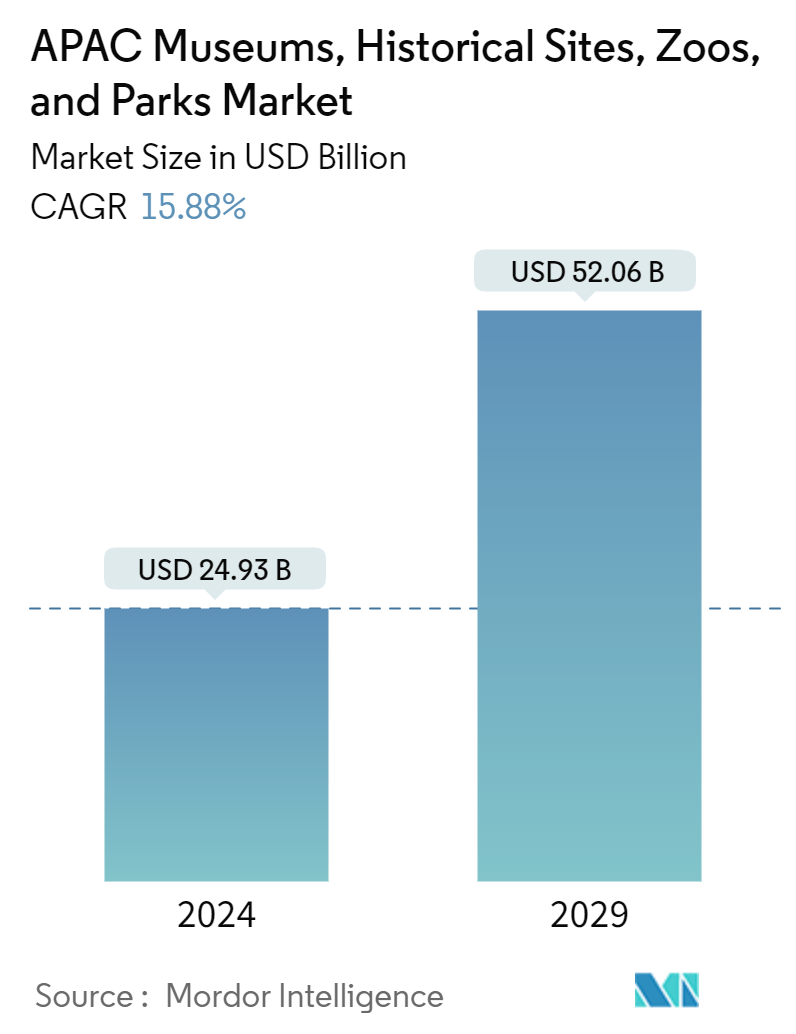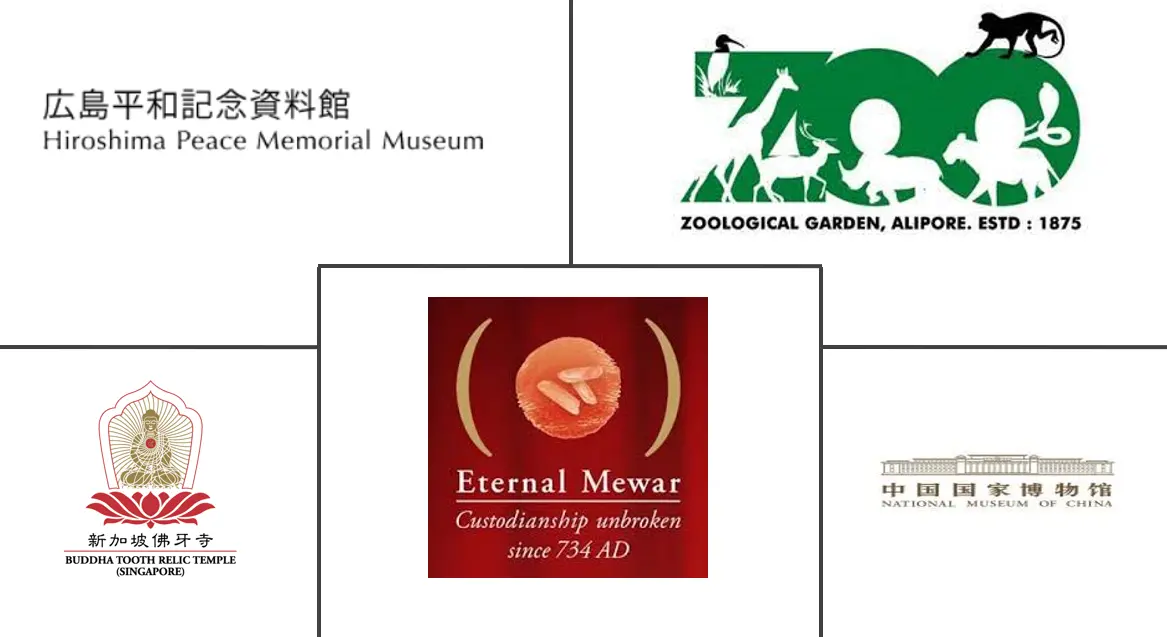Market Size of APAC Museums, Historical Sites, Zoos, And Parks Industry

| Study Period | 2020 - 2029 |
| Base Year For Estimation | 2023 |
| Market Size (2024) | USD 24.93 Billion |
| Market Size (2029) | USD 52.06 Billion |
| CAGR (2024 - 2029) | 15.88 % |
| Market Concentration | Medium |
Major Players
*Disclaimer: Major Players sorted in no particular order |
APAC Museums, Historical Sites, Zoos, And Parks Market Analysis
The APAC Museums, Historical Sites, Zoos, And Parks Market size is estimated at USD 24.93 billion in 2024, and is expected to reach USD 52.06 billion by 2029, growing at a CAGR of 15.88% during the forecast period (2024-2029).
The Asia-Pacific region attracts a significant number of domestic and international tourists, driving demand for cultural and recreational attractions such as museums, historical sites, zoos, and parks. The rapid economic development of countries such as China, India and Southeast Asian countries has resulted in a rise in disposable income and spending on leisure activities, boosting the tourism and entertainment sectors.
The rich cultural heritage of many countries in the Asia-Pacific region, including ancient civilizations, historical landmarks, and diverse wildlife, provides a strong foundation for the development of museums, historical sites, zoos, and parks.
Government investment in tourism infrastructure, conservation efforts, and cultural preservation projects plays a significant role in the development and maintenance of museums, historical sites, zoos, and parks. Urbanization trends in the Asia-Pacific region have led to increased demand for recreational spaces and cultural attractions in urban areas, driving the development of museums, parks, and other leisure facilities. Changing demographics, including an aging population and the rise of the middle class, influence visitor demographics and preferences, prompting attractions to adapt their offerings and marketing strategies accordingly.
Overall, the Asia-Pacific market for museums, historical sites, zoos, and parks is characterized by growth opportunities driven by tourism, economic development, cultural heritage, government support, and technological advancements.
APAC Museums, Historical Sites, Zoos, And Parks Industry Segmentation
A museum is where many one-of-a-kind and priceless goods, like historical artifacts or pieces of art, are maintained, examined, and presented to the general public. An official location where artifacts from social, political, or military history have been preserved for cultural heritage purposes is a historic site or heritage site. A zoo is a collection of wild animals kept in a park or garden for research, conservation, or public display. In contrast, a national park is a government-designated area for environmental preservation. The museums, historical sites, zoos, and parks report will cover insights into the world's museums, historical sites, zoos, and parks sector, drivers, and market restraints. The report will also cover information on some of the major players active in the region.
Asia-Pacific museums, historical sites, zoos, and parks are segmented by type, by revenue source, by geography. By type, the market is sub-segmented into museums, historical sites, zoos and botanical gardens, nature parks, and other similar institutions. By revenue source, the market is sub-segmented into tickets, food and beverages, and other revenue sources, and by geography Japan, China, India, Singapore, and the rest of Asia-Pacific. The market sizes and forecasts for Asia-Pacific museums, historical sites, zoos, and parks are provided in value (USD) for all the above segments.
| By Type | |
| Museums | |
| Historical Sites | |
| Zoos And Botanical Gardens | |
| Nature Parks | |
| Other Similar Institutions |
| By Revenue Source | |
| Tickets | |
| Food And Beverages | |
| Other Revenue Souces |
| By Country | |
| Japan | |
| China | |
| India | |
| Singapore | |
| Rest of Asia-Pacific |
APAC Museums, Historical Sites, Zoos, And Parks Market Size Summary
The Asia-Pacific market for museums, historical sites, zoos, and parks is experiencing significant growth, driven by a surge in domestic and international tourism. This growth is fueled by the region's rich cultural heritage, including ancient civilizations and diverse wildlife, which attract visitors to these cultural and recreational attractions. The rapid economic development in countries like China, India, and Southeast Asian nations has increased disposable income, leading to higher spending on leisure activities. Government investments in tourism infrastructure, conservation, and cultural preservation further bolster the development and maintenance of these attractions. Urbanization trends have also heightened the demand for recreational spaces in urban areas, prompting the expansion of museums, parks, and other leisure facilities. Additionally, changing demographics, such as an aging population and a rising middle class, are influencing visitor preferences, encouraging attractions to adapt their offerings and marketing strategies.
The market is characterized by the adoption of advanced digital technologies, such as digitization, 3D modeling, augmented reality, and virtual reality, enhancing visitor experiences. Notable examples include the Aigner Anna Zoological Park in Chennai, which has implemented live-streaming of animals, and various museums in China that offer interactive archaeological experiences. The competitive landscape features a multitude of players, including prominent institutions like the Hiroshima Peace Memorial Museum and the National Museum of China. Recent developments, such as the opening of the Robot & AI Museum in Seoul and the Museum of Art and Photography in Bengaluru, highlight the region's commitment to innovation and cultural engagement. These factors collectively contribute to the dynamic and evolving nature of the Asia-Pacific museums, historical sites, zoos, and parks market.
APAC Museums, Historical Sites, Zoos, And Parks Market Size - Table of Contents
-
1. MARKET DYNAMICS AND INSIGHTS
-
1.1 Market Overview
-
1.2 Market Drivers
-
1.2.1 Growing Popularity of Museums, Historical Sites, Zoos and Park is driving the Market Growth
-
1.2.2 Digitalized Experiences is Driving the Market
-
-
1.3 Market Restraints
-
1.3.1 Distinct institutional cultures and values
-
1.3.2 Adapting to the changes in technology is tough for the Institutions
-
-
1.4 Opportunities
-
1.4.1 Use of AI in the Museums, Historical Sites, Zoos, and Park
-
1.4.2 Packaged Tourism with different offers.
-
-
1.5 Value Chain Analysis
-
1.6 Industry Attractiveness: Porter's Five Forces Analysis
-
1.6.1 Bargaining Power of Buyers
-
1.6.2 Bargaining Power of Suppliers
-
1.6.3 Threat of New Entrants
-
1.6.4 Threat of Substitutes
-
1.6.5 Intensity of Competitive Rivalry
-
-
1.7 Insights into Technological Advancements in the Industry
-
1.8 Insights on Various Regulatory Trends Shaping the Market
-
1.9 Impact of COVID-19 on the Market
-
-
2. MARKET SEGMENTATION
-
2.1 By Type
-
2.1.1 Museums
-
2.1.2 Historical Sites
-
2.1.3 Zoos And Botanical Gardens
-
2.1.4 Nature Parks
-
2.1.5 Other Similar Institutions
-
-
2.2 By Revenue Source
-
2.2.1 Tickets
-
2.2.2 Food And Beverages
-
2.2.3 Other Revenue Souces
-
-
2.3 By Country
-
2.3.1 Japan
-
2.3.2 China
-
2.3.3 India
-
2.3.4 Singapore
-
2.3.5 Rest of Asia-Pacific
-
-
APAC Museums, Historical Sites, Zoos, And Parks Market Size FAQs
How big is the APAC Museums, Historical Sites, Zoos, And Parks Market?
The APAC Museums, Historical Sites, Zoos, And Parks Market size is expected to reach USD 24.93 billion in 2024 and grow at a CAGR of 15.88% to reach USD 52.06 billion by 2029.
What is the current APAC Museums, Historical Sites, Zoos, And Parks Market size?
In 2024, the APAC Museums, Historical Sites, Zoos, And Parks Market size is expected to reach USD 24.93 billion.

